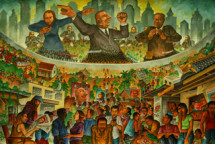Ideas into movement
Boost TNI's work
50 years. Hundreds of social struggles. Countless ideas turned into movement.
Support us as we celebrate our 50th anniversary in 2024.


At the same time as a democratic system is being revived in Myanmar after half a century of military dictatorship, so have strong challenges re-emerged, threatening not only the administration and the economy, but also more importantly, social and ethnic cohesion. While admitting that these challenges would tax any government and state, the weaknesses and inadequacies at the core have been revealed.
After five decades of junta or one-party rule, there is now a multi-party system. However, two-thirds of the 93 parties registered are ethnic-based parties, and almost exclusively single-ethnic. Twenty three political parties won seats in the bicameral parliament, but the picture is dominated by just two parties – the military-linked Union Solidarity and Development Party and the National League for Democracy.
With ideological decline, rudimentary election campaign platforms and minimal policy contestation, the stage was set for recourse to populism. Besides the Myanmar public’s widespread ejection of military government, populism played a large part in the NLD’s electoral successes. To fan or court this populism, or to deploy parallel ‘brands’ of it, use was made of what has been called nationalism. But this may be too polite a term, since the impetus came from inciting latent racist phobias and demonizing the ‘other’. The brunt of this wave fell upon a vulnerable ‘foreign’ community – the Muslims and particularly the Muslim Rohingya. 2017 saw the most extreme and brutal manifestation of this: a horrific campaign which the UN has described as amounting to genocide. At independence Myanmar had started off a little unsure of itself ideologically, while threatened by a far-left armed rebellion. With the collapse of the left in 1989, the swerve in the opposite direction began with a vengeance. With the right firmly in place now, one could say the presence of the left is called for, if only for the sake of balance. It is noteworthy however that the political left has virtually disappeared. This is not a case for a return to ideology of what stripe, but for the backstopping to look after the detritus that has been abandoned – the poor, the old, minorities and the marginalized.
This paper was presented at the Emancipatory Rural Politics Initiative (ERPI) 2018 Conference: "Authoritarian Populism and the Rural World"